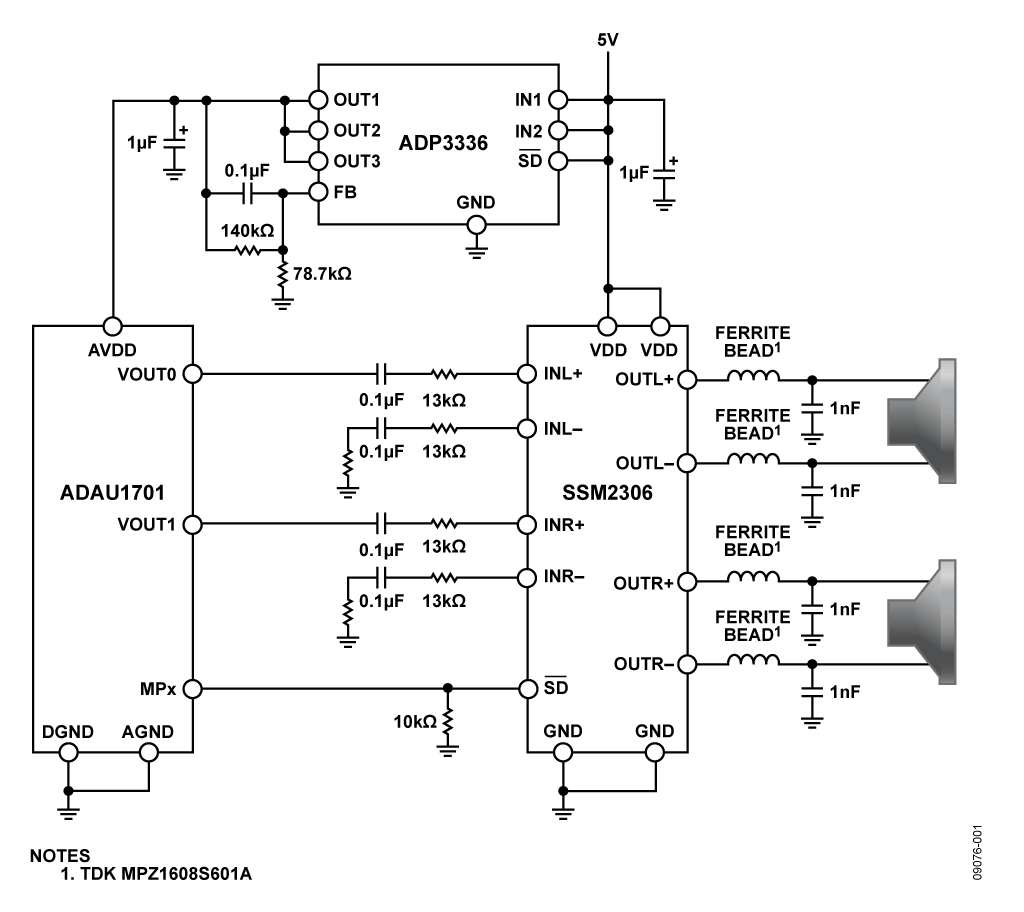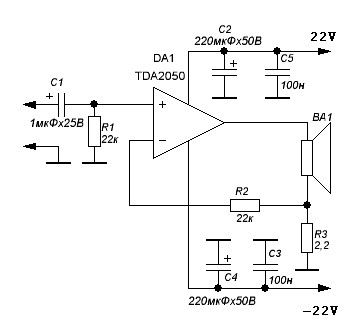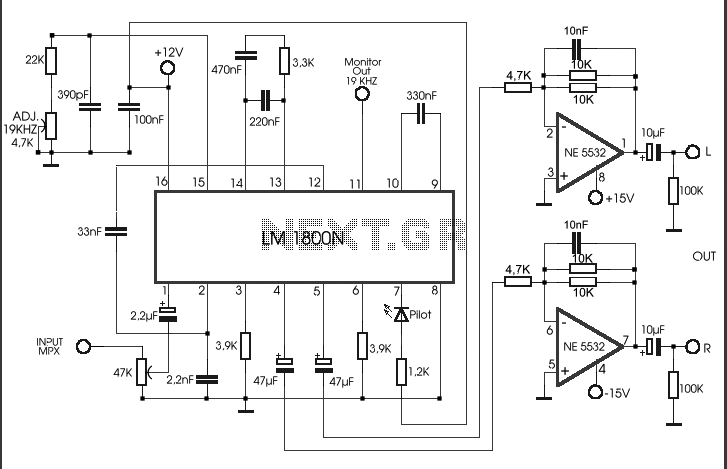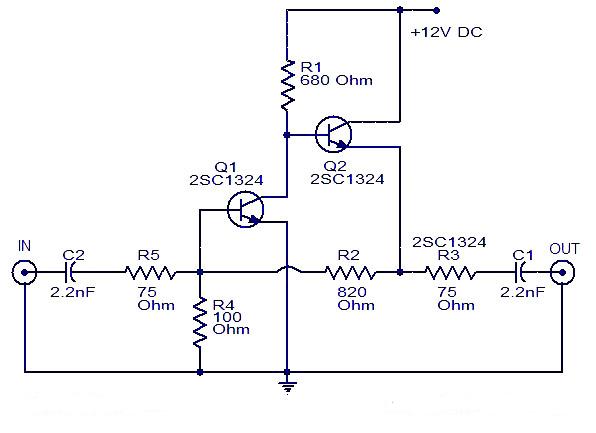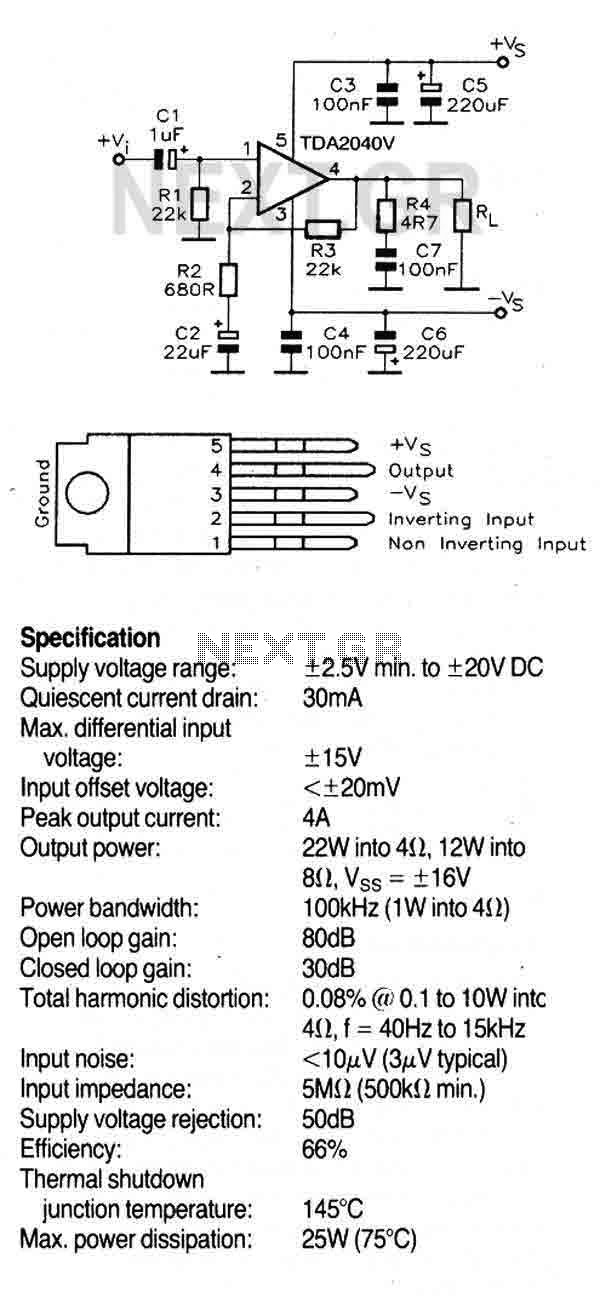
7 Tube Stereo Output Amplifier

This is a 7-tube, 20-watt amplifier that must be used in conjunction with a preamplifier featuring volume and tone controls. A suitable recommendation is a 6-tube preamplifier. This amplifier utilizes 6BQ5 output tubes and employs a 5U4-G rectifier to ensure a robust power supply for optimal performance. The design is based on a Magnavox amplifier purchased on eBay years ago and rebuilt after constructing the 6-tube amp. The sound quality is impressive, and the circuit is notably minimalist. Due to the output configuration, it is necessary to use a matched quartet of 6BQ5 tubes. The schematic includes a balance control, which is a preferred feature for compensating less than optimal speaker placement in a living room. Additionally, the amplifier incorporates a 6EU7 dual-triode for each channel and utilizes a unique phase-inverter circuit known as a "paraphase" inverter.
Note R4 and R24 indicate an optional fixed balance control; the 750-ohm 1/2-watt potentiometer can be omitted. The original balance control was integrated within the tuner. After using the amplifier without the tuner, two resistors were added in place of the potentiometer connections. Two 330-ohm resistors were installed and used for years before the rebuild, at which point a balance control potentiometer was added. A suitable potentiometer was found at a local electronics parts store, although many users have reported difficulty locating a 750-ohm potentiometer. In such cases, it is recommended to omit the potentiometer and utilize the 330-ohm resistors as shown in the schematic. It is advisable to install a 3-prong line cord and connect the chassis to ground, ensuring that the fused and switched side of the line is connected to the hot (black wire) side. For those interested in creating a standalone amplifier, a 2-gang 500K audio taper potentiometer can be used for the inputs. The amplifier provides sufficient gain when connected directly to a line-out device, although a volume control is recommended for optimal use.
The circuit design of this amplifier emphasizes simplicity while maintaining high-quality sound reproduction. The 6BQ5 output tubes are known for their warm tonal characteristics, making this amplifier suitable for a variety of audio applications. The inclusion of the 6EU7 dual-triode enhances the amplifier's performance by providing low noise and high gain, which is crucial for achieving a rich audio experience. The paraphase inverter circuit is particularly noteworthy, as it allows for effective phase splitting while minimizing distortion, a common challenge in amplifier design.
In terms of construction, attention should be given to the layout of components to minimize interference and maintain signal integrity. The power supply section should be adequately filtered to prevent hum and noise from affecting the audio output. The use of high-quality capacitors and resistors will contribute to the overall performance and longevity of the amplifier.
When implementing the balance control, it is essential to ensure that the resistors used are of equal value to maintain the integrity of the audio signal. If the decision is made to use the 330-ohm resistors instead of the potentiometer, careful consideration should be given to the placement of these components to achieve the desired audio balance.
Overall, this amplifier represents a blend of classic design principles and modern audio requirements, making it a valuable addition to any audio enthusiast's setup. The minimalist approach not only simplifies construction but also enhances the listening experience by focusing on essential audio performance.This is a 7 tube 20 watt amplifier that must be used in conjunction with a pre amplifier having volume an tone controls. For this, I recommend this 6 tube pre-amp. With this amplifier you may use 6BQ5 output tubes. A 5U4-G rectifier is used so that the power supply will have plenty of pep to run the amp. This amplifier is basically a Magnovox amp lifier I bought on ebay years ago and rebuilt after building the 6 tube amp. It is really amazing how it sounds, and the circuit is very minimalist, as you can see. Because of the output setup, you must use a quartet of matched 6BQ5 tubes. You will notice in looking at the schematic my preference for the balance control. I find this a convenient way to compensate for less than optimal speaker placement in my living room Above, the amplifier`s schematic. In addition to the 6BQ5 output tubes, a 6EU7 dual-triode is used in each channel. This amplifier also uses a curious phase-inverter circuit I have heard described as a "paraphase" inverter.
*Note R4 and R24, optional fixed balance control, omit 750 ohm 1/2 watt pot. The original balance control was mounted inside the tuner. When I began using this amplifier without the tuner, I had to add two resistors in place of the connections to the pots. For whatever reason, I installed two 330 ohm resistors and used the amp this way for years before the rebuilding when I added a balance control pot.
I was lucky to find a pot with the same value as the original at a real electronics parts store. Many readers have emailed saying they are having difficulty finding a 750 ohm pot. If this is the case for you, just omit the pot and use the 330-ohm resistors as shown. You may want to install a 3-prong line cord and connect the chassis to ground. Make sure the fused and switched side of the line is on the hot (black wire) side of the line. If you really wanted to, you could make this a stand-alone amp by using a 2-gang 500K audio taper pot for the inputs. I`ve noticed there`s plenty of gain in this amp connected directly to a line out device, but you`ll want a volume control.
🔗 External reference
Note R4 and R24 indicate an optional fixed balance control; the 750-ohm 1/2-watt potentiometer can be omitted. The original balance control was integrated within the tuner. After using the amplifier without the tuner, two resistors were added in place of the potentiometer connections. Two 330-ohm resistors were installed and used for years before the rebuild, at which point a balance control potentiometer was added. A suitable potentiometer was found at a local electronics parts store, although many users have reported difficulty locating a 750-ohm potentiometer. In such cases, it is recommended to omit the potentiometer and utilize the 330-ohm resistors as shown in the schematic. It is advisable to install a 3-prong line cord and connect the chassis to ground, ensuring that the fused and switched side of the line is connected to the hot (black wire) side. For those interested in creating a standalone amplifier, a 2-gang 500K audio taper potentiometer can be used for the inputs. The amplifier provides sufficient gain when connected directly to a line-out device, although a volume control is recommended for optimal use.
The circuit design of this amplifier emphasizes simplicity while maintaining high-quality sound reproduction. The 6BQ5 output tubes are known for their warm tonal characteristics, making this amplifier suitable for a variety of audio applications. The inclusion of the 6EU7 dual-triode enhances the amplifier's performance by providing low noise and high gain, which is crucial for achieving a rich audio experience. The paraphase inverter circuit is particularly noteworthy, as it allows for effective phase splitting while minimizing distortion, a common challenge in amplifier design.
In terms of construction, attention should be given to the layout of components to minimize interference and maintain signal integrity. The power supply section should be adequately filtered to prevent hum and noise from affecting the audio output. The use of high-quality capacitors and resistors will contribute to the overall performance and longevity of the amplifier.
When implementing the balance control, it is essential to ensure that the resistors used are of equal value to maintain the integrity of the audio signal. If the decision is made to use the 330-ohm resistors instead of the potentiometer, careful consideration should be given to the placement of these components to achieve the desired audio balance.
Overall, this amplifier represents a blend of classic design principles and modern audio requirements, making it a valuable addition to any audio enthusiast's setup. The minimalist approach not only simplifies construction but also enhances the listening experience by focusing on essential audio performance.This is a 7 tube 20 watt amplifier that must be used in conjunction with a pre amplifier having volume an tone controls. For this, I recommend this 6 tube pre-amp. With this amplifier you may use 6BQ5 output tubes. A 5U4-G rectifier is used so that the power supply will have plenty of pep to run the amp. This amplifier is basically a Magnovox amp lifier I bought on ebay years ago and rebuilt after building the 6 tube amp. It is really amazing how it sounds, and the circuit is very minimalist, as you can see. Because of the output setup, you must use a quartet of matched 6BQ5 tubes. You will notice in looking at the schematic my preference for the balance control. I find this a convenient way to compensate for less than optimal speaker placement in my living room Above, the amplifier`s schematic. In addition to the 6BQ5 output tubes, a 6EU7 dual-triode is used in each channel. This amplifier also uses a curious phase-inverter circuit I have heard described as a "paraphase" inverter.
*Note R4 and R24, optional fixed balance control, omit 750 ohm 1/2 watt pot. The original balance control was mounted inside the tuner. When I began using this amplifier without the tuner, I had to add two resistors in place of the connections to the pots. For whatever reason, I installed two 330 ohm resistors and used the amp this way for years before the rebuilding when I added a balance control pot.
I was lucky to find a pot with the same value as the original at a real electronics parts store. Many readers have emailed saying they are having difficulty finding a 750 ohm pot. If this is the case for you, just omit the pot and use the 330-ohm resistors as shown. You may want to install a 3-prong line cord and connect the chassis to ground. Make sure the fused and switched side of the line is on the hot (black wire) side of the line. If you really wanted to, you could make this a stand-alone amp by using a 2-gang 500K audio taper pot for the inputs. I`ve noticed there`s plenty of gain in this amp connected directly to a line out device, but you`ll want a volume control.
🔗 External reference
